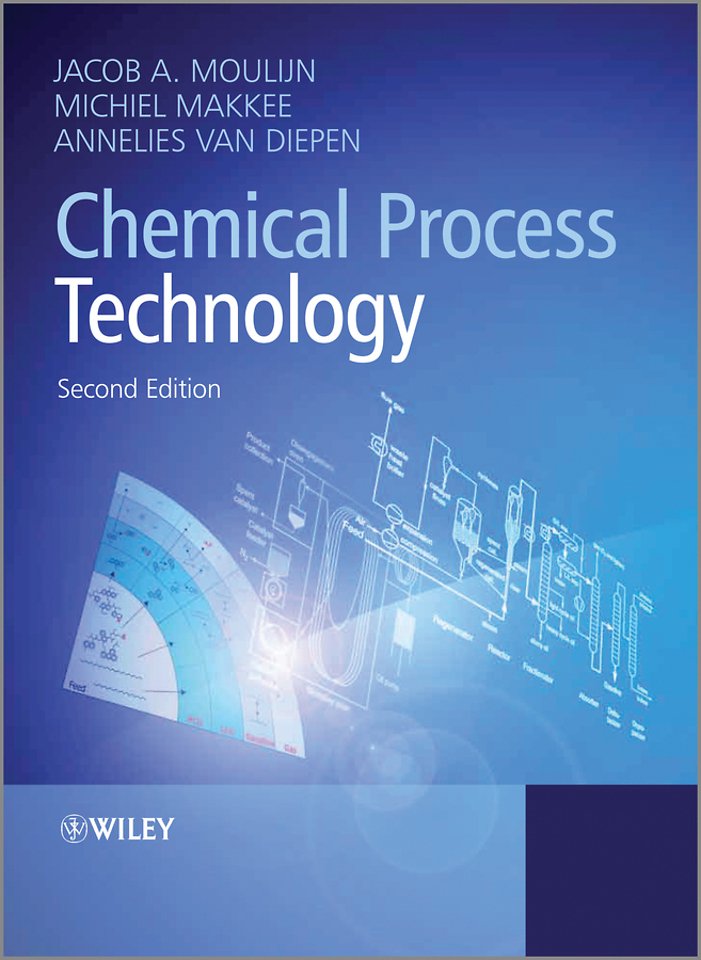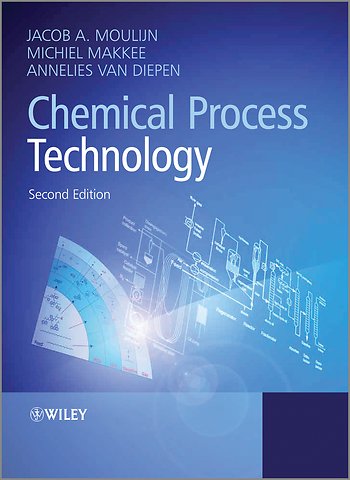Chemical Process Technology 2e
Samenvatting
With a focus on actual industrial processes, e.g. the production of light alkenes, synthesis gas, fine chemicals, polyethene, it encourages the reader to think out of the box and invent and develop novel unit operations and processes. Reflecting today s emphasis on sustainability, this edition contains new coverage of biomass as an alternative to fossil fuels, and process intensification.
The second edition includes:
New chapters on Process Intensification and Processes for the Conversion of Biomass
Updated and expanded chapters throughout with 35% new material overall
Text boxes containing case studies and examples from various different industries, e.g. synthesis loop designs, Sasol I Plant, Kaminsky catalysts, production of Ibuprofen, click chemistry, ammonia synthesis, fluid catalytic cracking
Questions throughout to stimulate debate and keep students awake!
Richly illustrated chapters with improved figures and flow diagrams
Chemical Process Technology, Second Edition is a comprehensive introduction, linking the fundamental theory and concepts to the applied nature of the subject. It will be invaluable to students of chemical engineering, biotechnology and industrial chemistry, as well as practising chemical engineers.
From reviews of the first edition:
The authors have blended process technology, chemistry and thermodynamics in an elegant manner Overall this is a welcome addition to books on chemical technology. The Chemist
Impressively wide–ranging and comprehensive an excellent textbook for students, with a combination of fundamental knowledge and technology. Chemistry in Britain (now Chemistry World)
Specificaties
Inhoudsopgave
<p>1 Introduction 1</p>
<p>References 6</p>
<p>General Literature 6</p>
<p>2 The Chemical Industry 7</p>
<p>2.1 A Brief History 7</p>
<p>2.1.1 Inorganic Chemicals 7</p>
<p>2.1.2 Organic Chemicals 10</p>
<p>2.1.3 The Oil Era 11</p>
<p>2.1.4 The Age of Sustainability 12</p>
<p>2.2 Structure of the Chemical Industry 13</p>
<p>2.3 Raw Materials and Energy 16</p>
<p>2.3.1 Fossil Fuel Consumption and Reserves 16</p>
<p>2.3.2 Biomass as an Alternative for Fossil Fuels 19</p>
<p>2.3.3 Energy and the Chemical Industry 21</p>
<p>2.3.4 Composition of Fossil Fuels and Biomass 23</p>
<p>2.4 Base Chemicals 35</p>
<p>2.5 Global Trends in the Chemical Industry 37</p>
<p>References 39</p>
<p>General Literature 40</p>
<p>3 Processes in the Oil Refinery 41</p>
<p>3.1 The Oil Refinery An Overview 41</p>
<p>3.2 Physical Processes 42</p>
<p>3.2.1 Desalting and Dehydration 42</p>
<p>3.2.2 Crude Distillation 43</p>
<p>3.2.3 Propane Deasphalting 45</p>
<p>3.3 Thermal Processes 46</p>
<p>3.3.1 Visbreaking 46</p>
<p>3.3.2 Delayed Coking 47</p>
<p>3.3.3 Flexicoking 48</p>
<p>3.4 Catalytic Processes 49</p>
<p>3.4.1 Octane and Cetane Numbers 49</p>
<p>3.4.2 Catalytic Cracking 51</p>
<p>3.4.3 Catalytic Reforming 63</p>
<p>3.4.4 Alkylation 69</p>
<p>3.4.5 Hydroprocessing 76</p>
<p>3.5 Current and Future Trends in Oil Refining 91</p>
<p>3.5.1 Stricter Environmental Regulations 92</p>
<p>3.5.2 Refinery Configurations 94</p>
<p>References 96</p>
<p>4 Production of Light Alkenes 99</p>
<p>4.1 Introduction 99</p>
<p>4.2 Cracking Reactions 100</p>
<p>4.2.1 Thermodynamics 100</p>
<p>4.2.2 Mechanism 101</p>
<p>4.2.3 Kinetics 102</p>
<p>4.3 The Industrial Process 103</p>
<p>4.3.1 Influence of Feedstock on Steam Cracker Operation and Products 103</p>
<p>4.3.2 Cracking Furnace 106</p>
<p>4.3.3 Heat Exchanger 109</p>
<p>4.3.4 Coke Formation 110</p>
<p>4.4 Product Processing 111</p>
<p>4.5 Novel Developments 113</p>
<p>4.5.1 Selective Dehydrogenation of Light Alkanes 114</p>
<p>4.5.2 Metathesis of Alkenes 116</p>
<p>4.5.3 Production of Light Alkenes from Synthesis Gas 118</p>
<p>4.5.4 Dehydration of Bioethanol 121</p>
<p>4.5.5 Direct Conversion of Methane 122</p>
<p>References 123</p>
<p>5 Production of Synthesis Gas 127</p>
<p>5.1 Introduction 127</p>
<p>5.2 Synthesis Gas from Natural Gas 129</p>
<p>5.2.1 Reactions and Thermodynamics 129</p>
<p>5.2.2 Steam Reforming Process 131</p>
<p>5.2.3 Autothermal Reforming Process 137</p>
<p>5.2.4 Novel Developments 139</p>
<p>5.3 Coal Gasification 142</p>
<p>5.3.1 Gasification Reactions 142</p>
<p>5.3.2 Thermodynamics 143</p>
<p>5.3.3 Gasification Technologies 146</p>
<p>5.3.4 Recent Developments in Gasification Technology 151</p>
<p>5.3.5 Applications of Coal Gasification 154</p>
<p>5.3.6 Integrated Gasification Combined Cycle 156</p>
<p>5.3.7 Why Gasify, Not Burn for Electricity Generation? 158</p>
<p>5.3.8 Carbon Capture and Storage (CCS) 159</p>
<p>5.4 Cleaning and Conditioning of Synthesis Gas 161</p>
<p>5.4.1 Acid Gas Removal 161</p>
<p>5.4.2 Water Gas Shift Reaction 163</p>
<p>5.4.3 Methanation 166</p>
<p>References 168</p>
<p>6 Bulk Chemicals and Synthetic Fuels Derived from Synthesis Gas 171</p>
<p>6.1 Ammonia 171</p>
<p>6.1.1 Background Information 171</p>
<p>6.1.2 Thermodynamics 173</p>
<p>6.1.3 Commercial Ammonia Synthesis Reactors 175</p>
<p>6.1.4 Ammonia Synthesis Loop 178</p>
<p>6.1.5 Integrated Ammonia Plant 180</p>
<p>6.1.6 Hydrogen Recovery 182</p>
<p>6.1.7 Production of Urea 185</p>
<p>6.2 Methanol 191</p>
<p>6.2.1 Background Information 191</p>
<p>6.2.2 Reactions, Thermodynamics, and Catalysts 192</p>
<p>6.2.3 Synthesis Gas for Methanol Production 195</p>
<p>6.2.4 Methanol Synthesis 196</p>
<p>6.2.5 Production of Formaldehyde 199</p>
<p>6.3 Synthetic Fuels and Fuel Additives 201</p>
<p>6.3.1 Fischer Tropsch Process 202</p>
<p>6.3.2 Methanol–to–Gasoline (MTG) Process 212</p>
<p>6.3.3 Recent Developments in the Production of Synthetic Fuels 214</p>
<p>6.3.4 Fuel Additives Methyl Tert–Butyl Ether 215</p>
<p>References 218</p>
<p>7 Processes for the Conversion of Biomass 221</p>
<p>7.1 Introduction 221</p>
<p>7.2 Production of Biofuels 223</p>
<p>7.2.1 Bioethanol and Biobutanol 224</p>
<p>7.2.2 Diesel–Type Biofuels 226</p>
<p>7.3 Production of Bio–based Chemicals 231</p>
<p>7.3.1 Ethanol 232</p>
<p>7.3.2 Glycerol 233</p>
<p>7.3.3 Succinic Acid 234</p>
<p>7.3.4 Hydroxymethylfurfural (HMF) 236</p>
<p>7.4 The Biorefinery 236</p>
<p>7.4.1 Biorefinery Design Criteria and Products 236</p>
<p>7.4.2 Biorefinery Concepts 238</p>
<p>7.4.3 Core Technologies of a Thermochemical Biorefinery 239</p>
<p>7.4.4 Existing and Projected Biorefineries 243</p>
<p>7.4.5 Possibility of Integrating a Biorefinery with Existing Plants 243</p>
<p>7.4.6 Biorefinery versus Oil Refinery 245</p>
<p>7.5 Conclusions 246</p>
<p>References 246</p>
<p>8 Inorganic Bulk Chemicals 249</p>
<p>8.1 The Inorganic Chemicals Industry 249</p>
<p>8.2 Sulfuric Acid 250</p>
<p>8.2.1 Reactions and Thermodynamics 252</p>
<p>8.2.2 SO2 Conversion Reactor 252</p>
<p>8.2.3 Modern Sulfuric Acid Production Process 254</p>
<p>8.2.4 Catalyst Deactivation 256</p>
<p>8.3 Sulfur Production 256</p>
<p>8.4 Nitric Acid 260</p>
<p>8.4.1 Reactions and Thermodynamics 260</p>
<p>8.4.2 Processes 262</p>
<p>8.4.3 NOx Abatement 266</p>
<p>8.5 Chlorine 268</p>
<p>8.5.1 Reactions for the Electrolysis of NaCl 269</p>
<p>8.5.2 Technologies for the Electrolysis of NaCl 270</p>
<p>References 274</p>
<p>9 Homogeneous Transition Metal Catalysis in the Production of Bulk Chemicals 275</p>
<p>9.1 Introduction 275</p>
<p>9.2 Acetic Acid Production 278</p>
<p>9.2.1 Background Information 278</p>
<p>9.2.2 Methanol Carbonylation Reactions, Thermodynamics, and Catalysis 281</p>
<p>9.2.3 Methanol Carbonylation Processes 284</p>
<p>9.3 Hydroformylation 286</p>
<p>9.3.1 Background Information 286</p>
<p>9.3.2 Thermodynamics 288</p>
<p>9.3.3 Catalyst Development 289</p>
<p>9.3.4 Processes for the Hydroformylation of Propene 292</p>
<p>9.3.5 Processes for the Hydroformylation of Higher Alkenes 294</p>
<p>9.3.6 Comparison of Hydroformylation Processes 296</p>
<p>9.4 Ethene Oligomerization and More 297</p>
<p>9.4.1 Background Information 297</p>
<p>9.4.2 Reactions of the SHOP Process 298</p>
<p>9.4.3 The SHOP Process 299</p>
<p>9.5 Oxidation of p–Xylene: Dimethyl Terephthalate and Terephthalic Acid Production 301</p>
<p>9.5.1 Background Information 301</p>
<p>9.5.2 Conversion of p–Toluic Acid Intermediate 302</p>
<p>9.5.3 Processes 303</p>
<p>9.5.4 Process Comparison 305</p>
<p>9.6 Review of Reactors Used in Homogeneous Catalysis 305</p>
<p>9.6.1 Choice of Reactor 306</p>
<p>9.6.2 Exchanging Heat 308</p>
<p>9.7 Approaches for Catalyst/Product Separation 308</p>
<p>9.7.1 Biphasic Catalyst Systems 309</p>
<p>9.7.2 Immobilized Catalyst Systems 309</p>
<p>References 311</p>
<p>10 Heterogeneous Catalysis Concepts and Examples 313</p>
<p>10.1 Introduction 313</p>
<p>10.2 Catalyst Design 314</p>
<p>10.2.1 Catalyst Size and Shape 314</p>
<p>10.2.2 Mechanical Properties of Catalyst Particles 316</p>
<p>10.3 Reactor Types and Their Characteristics 316</p>
<p>10.3.1 Reactor Types 316</p>
<p>10.3.2 Exchanging Heat 319</p>
<p>10.3.3 Role of Catalyst Deactivation 321</p>
<p>10.3.4 Other Issues 322</p>
<p>10.4 Shape Selectivity Zeolites 323</p>
<p>10.4.1 Production of Isobutene 325</p>
<p>10.4.2 Isomerization of Pentanes and Hexanes 328</p>
<p>10.4.3 Production of Ethylbenzene 330</p>
<p>10.5 Some Challenges and (Unconventional) Solutions 334</p>
<p>10.5.1 Adiabatic Reactor with Periodic Flow Reversal 334</p>
<p>10.5.2 Highly Exothermic Reactions with a Selectivity Challenge Selective Oxidations 338</p>
<p>10.6 Monolith Reactors Automotive Emission Control 344</p>
<p>10.6.1 Exhaust Gas Composition 346</p>
<p>10.6.2 Reduction of Exhaust Gas Emissions 347</p>
<p>References 354</p>
<p>General Literature 355</p>
<p>11 Production of Polymers Polyethene 357</p>
<p>11.1 Introduction 357</p>
<p>11.2 Polymerization Reactions 357</p>
<p>11.2.1 Step growth Polymerization 358</p>
<p>11.2.2 Chain growth Polymerization Radical and Coordination Pathways 360</p>
<p>11.3 Polyethenes Background Information 363</p>
<p>11.3.1 Catalyst Development 363</p>
<p>11.3.2 Classification and Properties 364</p>
<p>11.3.3 Applications 365</p>
<p>11.4 Processes for the Production of Polyethenes 366</p>
<p>11.4.1 Monomer Production and Purification 366</p>
<p>11.4.2 Polymerization Exothermicity 367</p>
<p>11.4.3 Production of Polyethenes 367</p>
<p>References 375</p>
<p>12 Production of Fine Chemicals 377</p>
<p>12.1 Introduction 377</p>
<p>12.2 Role of Catalysis 380</p>
<p>12.2.1 Atom Economy 380</p>
<p>12.2.2 Alternative Reagents and Catalysts 381</p>
<p>12.2.3 Novel Reaction Routes 384</p>
<p>12.2.4 Selectivity 384</p>
<p>12.2.5 Biocatalysis 392</p>
<p>12.3 Solvents 394</p>
<p>12.3.1 Conventional Solvents 394</p>
<p>12.3.2 Alternative Solvents 395</p>
<p>12.4 Production Plants 398</p>
<p>12.4.1 Multiproduct and Multipurpose Plants (MMPs) 398</p>
<p>12.4.2 Dedicated Continuous Plants 406</p>
<p>12.5 Batch Reactor Selection 407</p>
<p>12.5.1 Reactors for Liquid and Gas Liquid Systems 408</p>
<p>12.5.2 Reactors for Gas Liquid Solid Systems 409</p>
<p>12.6 Batch Reactor Scale–up Effects 411</p>
<p>12.6.1 Temperature Control 411</p>
<p>12.6.2 Heat Transfer 411</p>
<p>12.6.3 Example of the Scale–up of a Batch and Semi–Batch Reactor 412</p>
<p>12.6.4 Summary of the Scale–up of Batch Reactors 416</p>
<p>12.7 Safety Aspects of Fine Chemicals 416</p>
<p>12.7.1 Thermal Risks 416</p>
<p>12.7.2 Safety and Process Development 417</p>
<p>References 419</p>
<p>13 Biotechnology 423</p>
<p>13.1 Introduction 423</p>
<p>13.2 Principles of Fermentation Technology 424</p>
<p>13.2.1 Mode of Operation 425</p>
<p>13.2.2 Reactor Types 426</p>
<p>13.2.3 Sterilization 432</p>
<p>13.3 Cell Biomass Bakers Yeast Production 433</p>
<p>13.3.1 Process Layout 433</p>
<p>13.3.2 Cultivation Equipment 434</p>
<p>13.3.3 Downstream Processing 434</p>
<p>13.4 Metabolic Products Biomass as Source of Renewable Energy 435</p>
<p>13.4.1 Bioethanol and Biobutanol 435</p>
<p>13.4.2 Biogas 438</p>
<p>13.5 Environmental Application Wastewater Treatment 438</p>
<p>13.5.1 Introduction 438</p>
<p>13.5.2 Process Layout 438</p>
<p>13.5.3 Aerobic Treatment Processes 440</p>
<p>13.5.4 Anaerobic Treatment Processes 443</p>
<p>13.6 Enzyme Technology Biocatalysts for Transformations 445</p>
<p>13.6.1 General Aspects 445</p>
<p>13.6.2 Immobilization of Enzymes 446</p>
<p>13.6.3 Production of L–Amino Acids 447</p>
<p>13.6.4 Production of Artificial Sweeteners 448</p>
<p>References 452</p>
<p>General Literature 453</p>
<p>14 Process Intensification 455</p>
<p>14.1 Introduction 455</p>
<p>14.1.1 What is Process Intensification 455</p>
<p>14.1.2 How to Intensify Processes 457</p>
<p>14.2 Structured Catalytic Reactors 459</p>
<p>14.2.1 Types of Structured Catalysts and Reactors 460</p>
<p>14.2.2 Monoliths 462</p>
<p>14.2.3 Microreactors 468</p>
<p>14.3 Multifunctional Reactors/Reactive Separation 472</p>
<p>14.3.1 Reactive Distillation 473</p>
<p>14.3.2 Coupling Reaction and Membrane Separation 477</p>
<p>14.3.3 Coupling Reaction and Adsorption 481</p>
<p>References 482</p>
<p>15 Process Development 485</p>
<p>15.1 Dependence of Strategy on Product Type and Raw Materials 485</p>
<p>15.2 The Course of Process Development 487</p>
<p>15.3 Development of Individual Steps 489</p>
<p>15.3.1 Exploratory Phase 489</p>
<p>15.3.2 From Process Concept to Preliminary Flow Sheet 489</p>
<p>15.3.3 Pilot Plants/Miniplants 494</p>
<p>15.4 Scale–up 499</p>
<p>15.4.1 Reactors with a Single Fluid Phase 499</p>
<p>15.4.2 Fixed Bed Catalytic Reactors with One or More Fluid Phases 501</p>
<p>15.5 Safety and Loss Prevention 505</p>
<p>15.5.1 Safety Issues 505</p>
<p>15.5.2 Reactivity Hazards 511</p>
<p>15.5.3 Design Approaches to Safety 513</p>
<p>15.6 Process Evaluation 514</p>
<p>15.6.1 Capital Cost Estimation 515</p>
<p>15.6.2 Operating Costs and Earnings 523</p>
<p>15.6.3 Profitability Measures 524</p>
<p>15.7 Current and Future Trends 526</p>
<p>References 528</p>
<p>General Literature 529</p>
<p>Magazines 529</p>
<p>Appendix A Chemical Industry Figures 531</p>
<p>Appendix B Main Symbols Used in Flow Schemes 535</p>
<p>Index 539</p>

